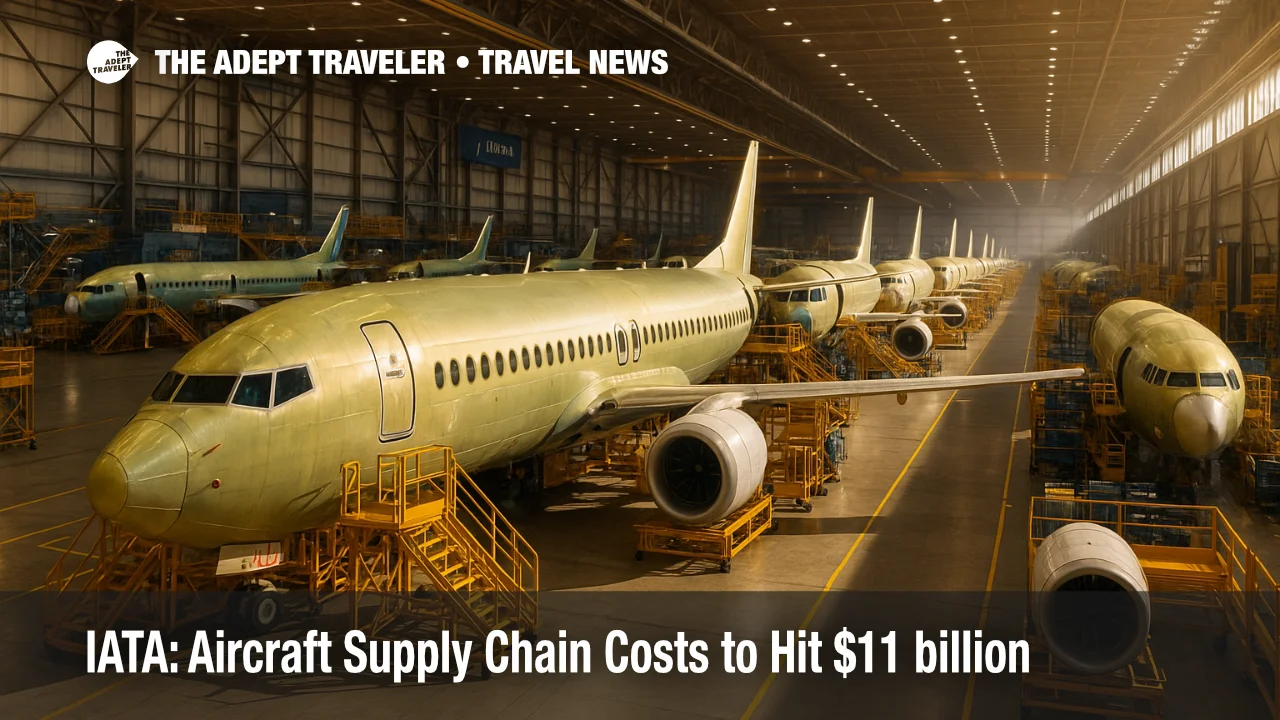IATA: Aircraft supply chain costs to hit $11 billion

A historic aircraft backlog and parts shortages are colliding with rising demand, pushing airline costs sharply higher. A new IATA, Oliver Wyman report estimates more than $11 billion in extra industrywide expenses for 2025, driven by fuel burn from older jets, heavier maintenance, engine leasing, and spare-parts stockpiles. With the global commercial backlog topping 17,000 aircraft in 2024, airlines face longer waits for deliveries, constrained capacity, and record load factors even as travelers keep flying.
Key points
- Why it matters: Supply chain delays raise costs, constrain seats, and pressure fares.
- Travel impact: Older aircraft stay in service longer, which can boost noise, fuel use, and maintenance downtime.
- What's next: Industry asks for more transparent, diversified parts and MRO markets.
- Record 17,000-jet backlog in 2024 limits growth as demand outpaces capacity.
- IATA outlines steps to open the aftermarket, add repair capacity, and share data.
Snapshot
IATA's analysis puts a price tag on the aircraft supply chain crunch: about $4.2 billion in extra fuel to run older fleets, $3.1 billion in additional maintenance, $2.6 billion for increased engine leasing, and $1.4 billion to carry surplus spares. The backlog for new aircraft exceeded 17,000 in 2024, well above the 2010 to 2019 average near 13,000. Demand keeps pressing upward, with 2024 passenger traffic up 10.4 percent against 8.7 percent capacity growth, yielding a record 83.5 percent load factor. That mismatch is why travelers still find full flights and limited schedule flexibility. IATA's recommendations include opening the aftermarket, boosting repair capacity, and improving supply chain visibility to reduce bottlenecks.
Background
Airlines plan fleets years ahead, counting on predictable delivery slots from aircraft and engine makers. Since the pandemic, that rhythm has broken. Labor shortages, geopolitical disruptions, raw-material constraints, and durability issues in certain engine families have stretched repair cycles and slowed production. With fewer new-technology jets arriving, carriers are extending leases and deferring retirements, which raises costs and keeps fuel burn elevated. The capacity squeeze reached a tipping point in 2024, when traffic growth outpaced seat growth, driving record utilization. Travelers feel this in fuller cabins, fewer off-peak bargains, and occasional aircraft substitutions when scheduled planes are unavailable.
Latest developments
Backlog and bottlenecks keep capacity tight as demand stays high
IATA's new joint study with Oliver Wyman quantifies the cost, highlights the record backlog, and calls for industrywide collaboration to open the aftermarket and share data. The group says airlines are paying more to keep older aircraft flying while they wait for deliveries. Importantly, the demand side shows little slack, with 2024 load factors at a record as traffic rose faster than capacity. On the manufacturer side, improving transparency around delivery schedules is helping airlines plan, but it does not eliminate the structural delays or repair-shop constraints. For U.S. readers tracking narrow-body timelines, see our related Insight on certification delays and knock-on capacity effects, Boeing 737 MAX 10 FAA delays and the capacity crunch, which explains how program timing can compound the aircraft supply chain challenge.
Analysis
The aircraft supply chain remains aviation's biggest brake on growth, not demand. When traffic expands faster than seats, revenue per available seat mile tends to firm, but operating costs can also rise if airlines rely on older, less efficient jets. That is exactly what IATA's cost breakdown shows, with fuel and maintenance leading the tab. For travelers, this dynamic helps explain sticky fares and full flights even outside holidays. For the industry, the leverage points are mostly offstage: open the maintenance and parts aftermarket to more competition, accelerate repair turn times, and add transparency across supplier tiers so predictable bottlenecks can be managed earlier. Regulators also play a role. Certification pacing, parts approvals, and standards that safely enable used serviceable material can all reduce downtime. Meanwhile, fleet planners must hedge delivery risk with leased capacity, schedule buffers, and realistic retirement timelines. Until production and repair capacity catch up, the aircraft supply chain will keep shaping prices, fleet age, and reliability.
Final thoughts
As airlines navigate 2025, the balance of strong demand and thin capacity will persist. Travelers should expect high load factors and limited last-minute deals, especially on routes relying on aging equipment. The relief valve is not quick; it depends on faster output, expanded repair capacity, and a more competitive aftermarket. For now, the aircraft supply chain is the story behind crowded flights and elevated costs.
